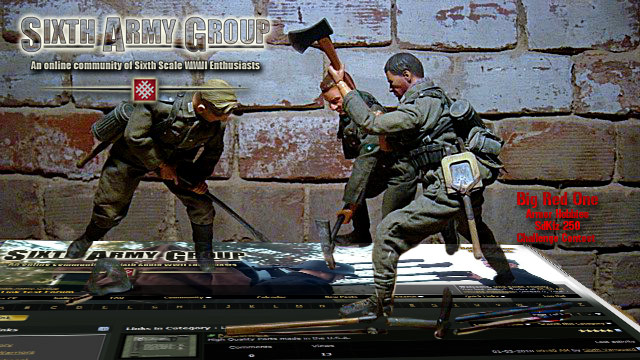Sixth Vanguard
Board Flunky, aka Site Admin
Unterfeldwebel Armin Stachow, Panzer Pioniere, Panzer division Feldherrnhalle, Budapest february the11th 1945
On the night of february the 11th some 16.000 german troops who were the remnants of the garrison attempted a breakout from the besieged city of Budapest. Before they left wounded survivors pleaded to be killed rather than fall captive to the Soviet forces. Most of the break-out group were surrounded and killed and only 800 reached safety – among them several men from the Feldherrnhalle Panzer division.
Here Armin Stachow are smoking one last cigarette to calm his nerves before the order for the breakout is given. His empty stare reflects his fatigue and perspective – chances for survival are nil. He is wearing a second pattern Panzerjacke – a very rare model with the twisted piping of black and white for Panzer Pioniere – the arms colour for engineers was black – but it presented an aesthetic problem – since the waffenfarbe was black, this would not show up on the panzerdienttanzug – the solution was a more visible piping of black-and-white twist cord form use on collars, collar patches, shoulder straps, and sidecaps.
Armin are only wearing a thin camouflage smock over his panzerjacke (with the hood removed – maybe for a helmet cover) – as Pz. Div. Feldherrnhalle was send to Hungary in the autum and the city was surrounded in December – long before sufficient winter clothing reached the defenders.
As a veteran of the first winter in Russia he has made sure to show his “frozen meat” ribbon along with his second class iron cross ribbon. As the panzerjacke has no NCO tresse on the collar his has sewn the double rank bars on his smock.
Armin is a panzer pioniere – an integral part of every panzer division – with task from clearing the way for the panzers through minefields and over obstacles – often under fire; to preparing defensive positions – including killingfields of mines, fields of fire and natural and manmade obstacles.
As the war progressed their role became more and more defensive – including tanks hunting and serving flamethrowers to stop or blunt enemy attacks.
The battle for Budapest raged from the Soviet forces crossed the Hungarian borders in March 1944 to the last defences of Budapest finally collapses on the 16th of February 1945. It is said to be the “Stalingrad of the SS” as several SS divisions was involved either in Budapest itself or in the attempts to relieve the city. But a lot of other units was sharing their fate – among the them Panzer division Feldherrnhalle:
The Feldherrnhalle was indeed several units as it was changed several time and annihilated 2 times; - 110.Panzer-Brigade Feldherrnhalle
The 110.Panzer-Brigade Feldherrnhalle was the second Feldherrnhalle panzer brigade. Formed from a cadre of SA men, the 110th was strongly equipped with a battalion of Panthers and a battalion of mechanised infantry. The 110th was sent to Romania, where it supported the forces of Army Group South Ukraine during the withdrawal into Hungary. The brigade, along with the reformed Panzergrenadier-Division Feldherrnhalle took part in the Battle of Debrecen in October 1944, acquitting itself well. During these battles, the 110th fought alongside the 13.Panzer-Division. In November 1944, the brigade was disbanded and absorbed into the 13.Panzer. As a result, the 13.Panzer was renamed 13.Panzer-Division Feldherrnhalle.
Panzergrenadier-Division Feldherrnhalle
The Panzergrenadier-Division Feldherrnhalle was only partially formed by September 1944, when it was ordered to the Front in Hungary to strengthen Armeegruppe Fretter-Pico, which was threatening to collapse in the face of a major soviet offensive near Oradea and Debrecen. The division, only the size of a brigade, was committed to battle in mid October, ordered to hold a major crossing point on the Tisza River. When the Soviet spearhead threatened to encircle several panzer divisions near Debrecen, the division was thrown into battle in an ultimately successful attempt to cut off and annihilate the Soviet units. During the following battle, the division fought alongside both the 13.Panzer-Division Feldherrnhalle and schwere-Panzer-Abteilung 503 for the first time.
After enjoying major success of the Battle of Debrecen, the division fought in co-operation with schwere-Panzer-Abteilung 503 and was soon involved in the withdrawal towards Budapest. The Panzergrenadier Division, sPzAbt 503 and the 13.Panzer Feldherrnhalle, by now exhausted and dangerously understrength, were pushed back into the city. On 21 December 1944, the sPzAbt 503 was renamed schwere-Panzer-Abteilung Feldherrnhalle.
On December 31, the three formations were encircled along with IX.SS-Gebirgskorps. For the next month, the Feldherrnhalle units desperately held out for rescue. After the failure of Operation Konrad, Armeegruppe Balck's rescue attempts, the pocket collapsed and the divisions were destroyed on 12 February, 1945. Among those to escape the pocket was a group of several hundred Feldherrnhalle men.
It is not known if Armin was among them...
[hr:45c1b6cf90]
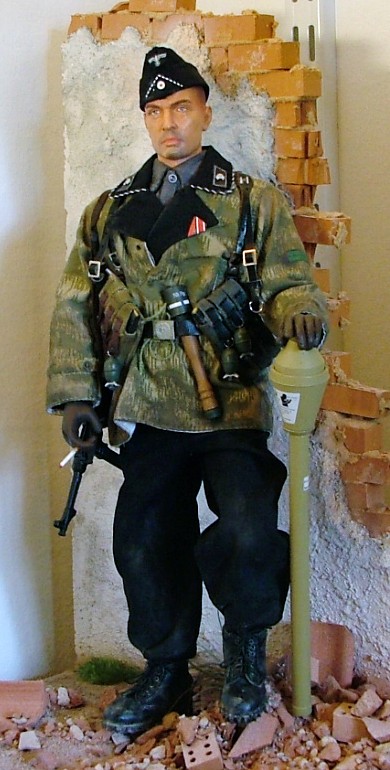
[hr:45c1b6cf90]
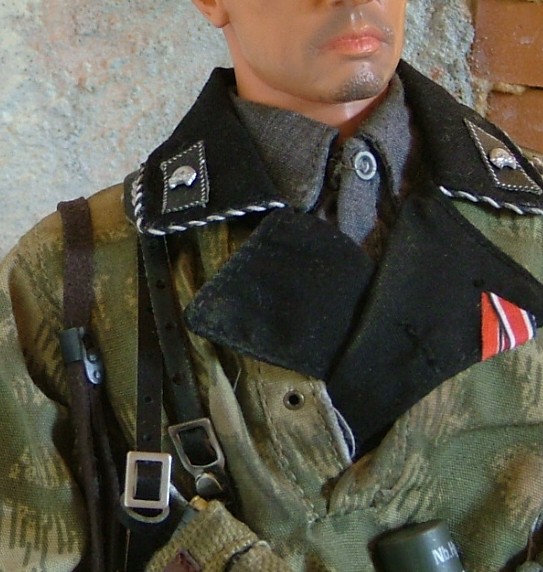
[hr:45c1b6cf90]
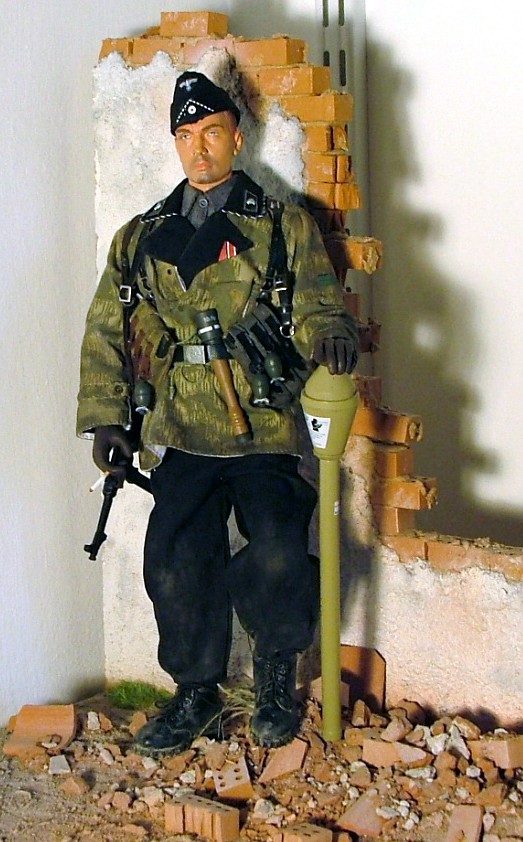
[hr:45c1b6cf90]
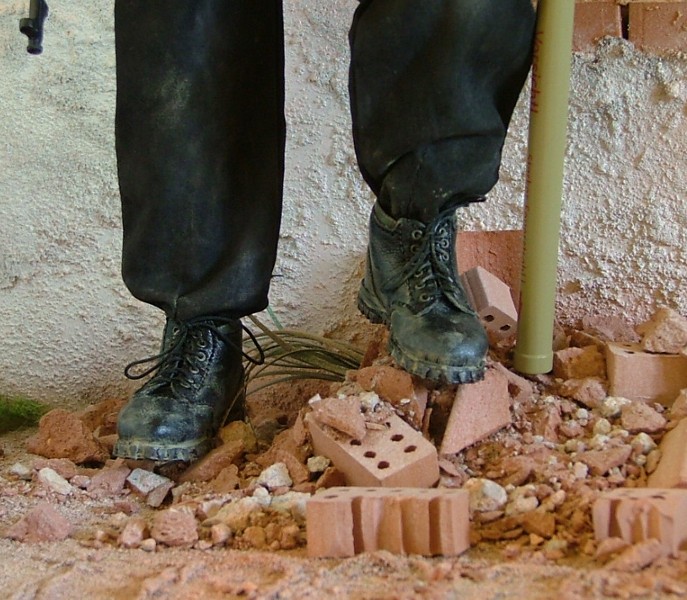
[hr:45c1b6cf90]
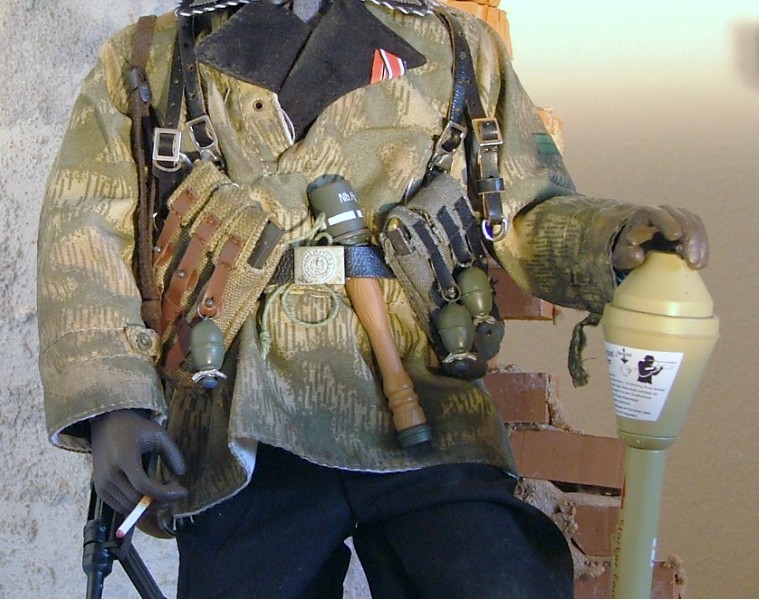
[hr:45c1b6cf90]
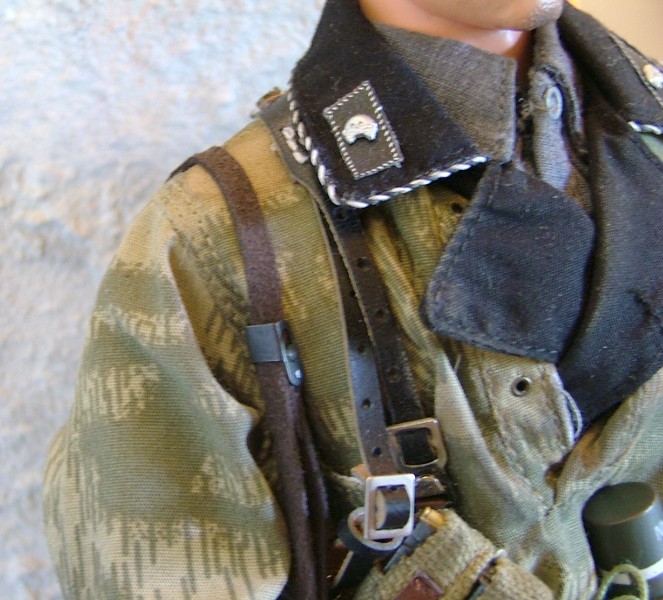
[hr:45c1b6cf90]
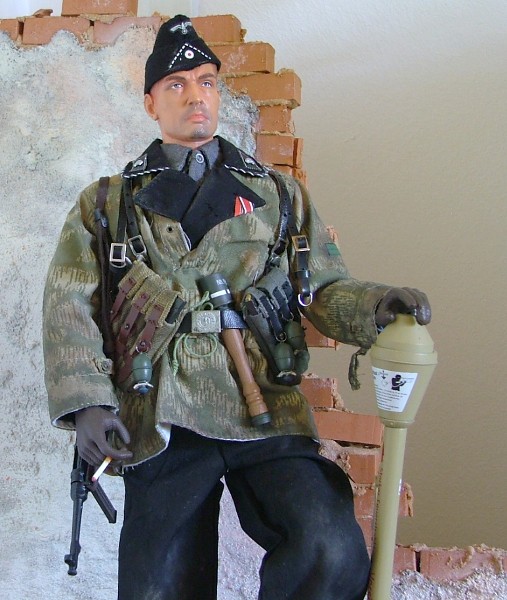
[hr:45c1b6cf90]
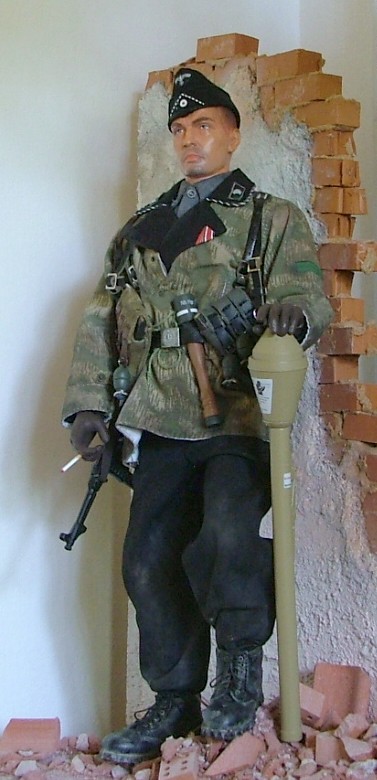
[hr:45c1b6cf90]
The stuff used is DID and DML – all stuff weathered, the smock altered, and the piping on the collar made by glue-twisting black and white tread. The insignia are DML and CVI.
On the night of february the 11th some 16.000 german troops who were the remnants of the garrison attempted a breakout from the besieged city of Budapest. Before they left wounded survivors pleaded to be killed rather than fall captive to the Soviet forces. Most of the break-out group were surrounded and killed and only 800 reached safety – among them several men from the Feldherrnhalle Panzer division.
Here Armin Stachow are smoking one last cigarette to calm his nerves before the order for the breakout is given. His empty stare reflects his fatigue and perspective – chances for survival are nil. He is wearing a second pattern Panzerjacke – a very rare model with the twisted piping of black and white for Panzer Pioniere – the arms colour for engineers was black – but it presented an aesthetic problem – since the waffenfarbe was black, this would not show up on the panzerdienttanzug – the solution was a more visible piping of black-and-white twist cord form use on collars, collar patches, shoulder straps, and sidecaps.
Armin are only wearing a thin camouflage smock over his panzerjacke (with the hood removed – maybe for a helmet cover) – as Pz. Div. Feldherrnhalle was send to Hungary in the autum and the city was surrounded in December – long before sufficient winter clothing reached the defenders.
As a veteran of the first winter in Russia he has made sure to show his “frozen meat” ribbon along with his second class iron cross ribbon. As the panzerjacke has no NCO tresse on the collar his has sewn the double rank bars on his smock.
Armin is a panzer pioniere – an integral part of every panzer division – with task from clearing the way for the panzers through minefields and over obstacles – often under fire; to preparing defensive positions – including killingfields of mines, fields of fire and natural and manmade obstacles.
As the war progressed their role became more and more defensive – including tanks hunting and serving flamethrowers to stop or blunt enemy attacks.
The battle for Budapest raged from the Soviet forces crossed the Hungarian borders in March 1944 to the last defences of Budapest finally collapses on the 16th of February 1945. It is said to be the “Stalingrad of the SS” as several SS divisions was involved either in Budapest itself or in the attempts to relieve the city. But a lot of other units was sharing their fate – among the them Panzer division Feldherrnhalle:
The Feldherrnhalle was indeed several units as it was changed several time and annihilated 2 times; - 110.Panzer-Brigade Feldherrnhalle
The 110.Panzer-Brigade Feldherrnhalle was the second Feldherrnhalle panzer brigade. Formed from a cadre of SA men, the 110th was strongly equipped with a battalion of Panthers and a battalion of mechanised infantry. The 110th was sent to Romania, where it supported the forces of Army Group South Ukraine during the withdrawal into Hungary. The brigade, along with the reformed Panzergrenadier-Division Feldherrnhalle took part in the Battle of Debrecen in October 1944, acquitting itself well. During these battles, the 110th fought alongside the 13.Panzer-Division. In November 1944, the brigade was disbanded and absorbed into the 13.Panzer. As a result, the 13.Panzer was renamed 13.Panzer-Division Feldherrnhalle.
Panzergrenadier-Division Feldherrnhalle
The Panzergrenadier-Division Feldherrnhalle was only partially formed by September 1944, when it was ordered to the Front in Hungary to strengthen Armeegruppe Fretter-Pico, which was threatening to collapse in the face of a major soviet offensive near Oradea and Debrecen. The division, only the size of a brigade, was committed to battle in mid October, ordered to hold a major crossing point on the Tisza River. When the Soviet spearhead threatened to encircle several panzer divisions near Debrecen, the division was thrown into battle in an ultimately successful attempt to cut off and annihilate the Soviet units. During the following battle, the division fought alongside both the 13.Panzer-Division Feldherrnhalle and schwere-Panzer-Abteilung 503 for the first time.
After enjoying major success of the Battle of Debrecen, the division fought in co-operation with schwere-Panzer-Abteilung 503 and was soon involved in the withdrawal towards Budapest. The Panzergrenadier Division, sPzAbt 503 and the 13.Panzer Feldherrnhalle, by now exhausted and dangerously understrength, were pushed back into the city. On 21 December 1944, the sPzAbt 503 was renamed schwere-Panzer-Abteilung Feldherrnhalle.
On December 31, the three formations were encircled along with IX.SS-Gebirgskorps. For the next month, the Feldherrnhalle units desperately held out for rescue. After the failure of Operation Konrad, Armeegruppe Balck's rescue attempts, the pocket collapsed and the divisions were destroyed on 12 February, 1945. Among those to escape the pocket was a group of several hundred Feldherrnhalle men.
It is not known if Armin was among them...
[hr:45c1b6cf90]

[hr:45c1b6cf90]

[hr:45c1b6cf90]

[hr:45c1b6cf90]

[hr:45c1b6cf90]

[hr:45c1b6cf90]

[hr:45c1b6cf90]

[hr:45c1b6cf90]

[hr:45c1b6cf90]
The stuff used is DID and DML – all stuff weathered, the smock altered, and the piping on the collar made by glue-twisting black and white tread. The insignia are DML and CVI.
